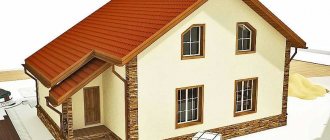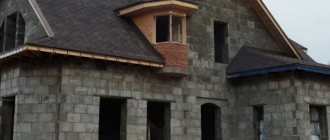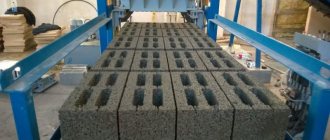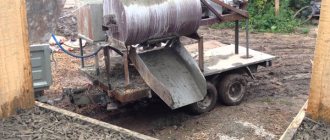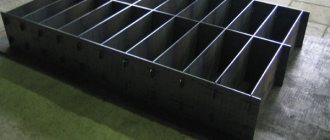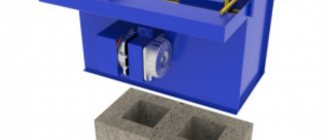Arbolite, as a building material, was known back in the days of the USSR, factories were operating and houses were being built. After the collapse of the country, the technology was forgotten for some time, and a few years ago it was remembered again. The material is warm, light, durable, does not conduct sound well, and is also inexpensive. Therefore, wood concrete and wood concrete blocks (arbolite blocks) are increasingly of interest to private developers.
Let’s immediately determine that wood concrete and sawdust concrete are different materials with different characteristics. Wood concrete contains waste from the woodworking industry, but only in a strictly regulated size. There is no other filler anymore. Moreover, everything is prescribed in GOSTs and instructions. And the filler is not sawdust, but wood chips with dimensions recommended by the standard of no more than 40*10*5 mm.
GOST standards with a regulatory framework for wood concrete
Properties, advantages and disadvantages
For a private developer, when choosing a building material, the technical characteristics of the material are important. Let's look at wood concrete blocks from this side. So, the characteristics and their brief explanation:
- Thermal conductivity - 0.08 - 0.14 W/m°C (depending on density, the higher the density, the higher the thermal conductivity). Characteristics comparable to wood. It has this indicator of 0.14 W/m°C, for ceramic brick it is 0.6-0.95 W/m°C. That is, a building made from arbolite blocks will be warm, and the width of the walls will be small. For central Russia, in permanent residences, it is recommended to make walls 30-40 cm thick.
- Frost resistance - 25-50 cycles. This parameter means that the walls can freeze/thaw from 25 to 50 times without compromising their qualities (depending on the manufacturer). If the house is a permanent residence, then it will not freeze at all. For unheated dachas, a service life of 25-50 years is quite acceptable.
- Compressive strength - 0.5-5 MPa. This is one of the most attractive features of wood concrete - it is difficult to destroy. Another point: it restores its shape after removing the load. That is, hitting with a sledgehammer can make a dent, but after a while it will level out - partially or completely depending on the “severity” of the damage caused.
Technical characteristics of arbolite blocks - Bending strength 0.7-1 MPa. This means that if any distortions appear in the structure (the foundation has settled unevenly), the wood concrete blocks will not burst and will compensate for a sufficiently large load.
The properties are very good. Another thing is that they will only be provided that the proportions and technology are strictly observed. This is why arblite blocks are dangerous: you don’t know how well they are made.
Performance characteristics
As you can see, the characteristics of the arboblock are quite good. The advantages also include light weight, large size and good ability to absorb sounds. A very big plus is that the blocks are easy to cut and can be easily given the desired shape. Another positive point is that wood concrete holds nails and screws well. There are no problems on this side either.
- Shrinkage - 0.5-0.6%. This parameter shows how much the geometric dimensions of the wall will change under load. Wood concrete has one of the lowest rates.
- Water absorption 40-85%. This figure is very large. If you put an arbolite block in water, it can absorb a lot of water. For the developer, this means that care must be taken to ensure good waterproofing between the foundation and the first row of blocks. An arbolite house also needs exterior finishing that will protect the material from moisture. It's not all that scary. It is much more important that the hygroscopicity of wood concrete is low (the ability to accumulate vaporous moisture). Even with very humid air, it does not become damp, but allows vapor to pass through itself, regulating the humidity in the room.
- Fire resistance - class G1. Arbolite refers to materials that do not support combustion. This is their undoubted advantage.
If we talk about technical characteristics, then there is essentially one serious disadvantage - high water absorption. There is one more drawback, but it is from the field of operation. Mice love arbolite very much. The material is natural and warm. The problem can be solved by making a high base - no lower than 50 cm.
Calculation of raw material consumption
Calculate the required amount of wood concrete based on the total area of the load-bearing walls minus the area of the openings.
- If you intend to make standard blocks of 20x30x50 cm, then one block in the plane of the wall occupies 0.20 x 0.50 = 0.1 m².
- Dividing the total area of the walls in m² by 0.1 m², you will get the number of wood concrete blocks in pieces.
- The amount of finished wall material is measured in cubic meters. The volume of one block is 0.03 m³.
- 1 m³ of wood concrete consists of 33 blocks.
To make 1 m³ of wood concrete you will need:
- 250–300 kg of Portland cement.
- 250–300 kg of dry filler.
- 400 liters of water.
- 8–10 kg of chemical additives.
Equipment and tools
There are machines for sale for making wood concrete blocks at home. They make labor-intensive work easier and faster, but are expensive. If you need wall material only for your home, and you are not afraid of the length of the process, you can do without expensive equipment.
You will need:
- forced action concrete mixer;
- shovel;
- block molds;
- polyethylene film;
- wooden pallets;
- hammer;
- tamper block.
For the production of wood concrete, a forced-action concrete mixer is used
The form is made of steel sheet or wooden formwork. The metal mold consists of two parts. The box is made of steel with a cross-section of 1.0–1.5 mm. Its size is 30 x 50 cm, height 30 cm. The lid is made of steel with a cross-section of 3.0 mm and measures 33 x 53 cm. Apply clearly visible marks on the inner walls of the box at a height of 20.5 cm from the bottom. It’s even better to weld hooks about 5 mm high along the mark line, which will fix the lid to the given block thickness.
The mold for wood concrete blocks is made of steel with a cross section of 1.0–1.5 mm
Wooden formwork can be made from edged boards: a box with dimensions along the inner walls of 31 x 51 cm and a press cover 33 x 53 cm. The height of the box is 30 cm. The inner walls of the box and the bottom of the cover should be covered with linoleum so that the concrete mass does not stick to them surfaces.
Technology for the production of wood concrete blocks
Arbolite belongs to lightweight concrete, the technology is almost standard, with the exception of some nuances: the need for pressing and the use of a forced concrete mixer when mixing, not an ordinary gravity one. It mixes the wood chips better with the other ingredients.
Compound
The composition of wood concrete includes four components:
- high-quality cement (M 400 or M 500);
- wood chips;
- water;
- chemical additives.
Composition of wood concrete
Cement must be dry and fresh. Chips are of a certain size. The less misgrading there is, the stronger the block will be. Chemical additives are calcium nitrate and chloride (food additive E509), liquid glass, aluminum sulfate and some other substances. Please note that they are first diluted in water and only then added to the wood chips and mixed. Any drinking water is allowed, but not industrial water, without contamination. After the wood chips are evenly wet, cement is added. Any other sequence is not allowed.
Types and sizes of blocks
Depending on the density, wood concrete blocks are divided into thermal insulation (up to 500 kg/m3) and structural (from 500 kg/m3 to 850 kg/m3). To build one-story houses, you can use the lightest structural ones with a density of 500 kg/m3. For mansions of 1.5 and 2 floors, the minimum density is 600 kg/m3 and above.
The sizes of arbolite blocks can be different. The most common is 500*200 mm and different thicknesses - from 100 mm to 400-500 mm. But different factories and workshops produce blocks of different sizes. The molds for them can be welded from ordinary sheet iron, so this is not a problem. The photo shows an example of the assortment of one of the workshops.
Dimensions and weight of wood concrete blocks
As you can see, blocks of 600*200 mm and 600*250 mm are also available and thicknesses range from 100 to 500 mm. You can choose suitable ones for load-bearing walls and interior partitions. You can also make a suitable shape for making wood concrete blocks yourself. That is if you decide to make them yourself.
Proportions
Like any building material, wood concrete is divided into strength classes. For the construction of load-bearing walls of houses, the required strength class is B 2.5.
The number and proportions of wood concrete components depending on the brand
The amount of necessary materials per cubic meter of wood concrete mortar is in the table (photo above).
Pressing technologies
All these components are mixed and blocks are formed from them. There are several technologies:
- simply by pressing: manually on the floor (great effort required);
- manual rammer on a vibrating table.
The easiest way to do this is by hand pressing. But it is difficult to control the density and strength of the resulting blocks in this way.
Manual molding of wood concrete blocks
Normal production conditions
For the normal process of cement hydration, a temperature of at least +12°C is required. There are no other conditions. The peculiarity of production is that after molding the block, at least 2-3 weeks must pass before it can be used. During this time, the cement will gain about 50-60% strength (depending on temperature) and you can already work with the blocks. That is, blocks must be made long before construction begins. If you consider that the wood chips must sit for at least 4 months before they are used, then you can start a year before construction.
This is how you can store wood concrete blocks made by yourself
Another practical point: if you are going to make wood concrete blocks with your own hands, in addition to a platform for mixing and storing components, you need a platform for settling the blocks. The place should be covered, protected from rain and sun. There should be no drafts either.
Making wood concrete yourself: instructions for beginners
Before moving directly to the step-by-step production of arboblocks, it is worth mentioning several nuances:
- CANNOT for wood concrete . Just wood chips.
- Almost any woodworking waste is suitable for obtaining filler - slabs, branches, timber trimmings, tree tops.
- If you plan to use large-sized wood concrete blocks (for example, long transverse beams) in the building structure, then you should take care of their additional reinforcement. We are talking not only about the strength frame, but also about the rigging loops for easy transportation.
Please note: the best wood for wood concrete blocks is considered to be coniferous species: pine, spruce. Deciduous trees include birch, poplar, and aspen. It is strictly not recommended to use waste from larch, beech, and elm to make wood concrete.
Compound
For wood concrete, high grade cement is used - M-400 and M-500 . Be sure to keep the cement fresh and dry.
Wood chips, as already mentioned, must be crushed to certain sizes - 25x8x5 mm (optimum) or 40x10x5 (maximum) mm. Try to avoid high concentrations of misgrade - because of it, the final strength of the arboblock will decrease.
The following chemical additives are used:
- Food additive E509 – calcium chloride and nitrate.
- Aluminum sulfate.
- Liquid glass.
- The water used is potable (from the tap). You should not make an arbolite mixture using water from reservoirs - dirt and other impurities will destabilize the connecting connections between the components of the block, which will cause its premature destruction.
IMPORTANT: Follow the procedure when mixing ingredients. Remember firmly: first we mix water and chemical impurities, then add wood chips there and only after it is evenly wet, add cement.
Dimensions of arbolite blocks
Arboblocks are classified by density into:
- Structural - from 500 to 850 kg/m3.
- Thermal insulation – up to 500 kg/m3.
Which blocks you will use directly depends on the building being constructed. For a two-story building or a one-story house with a basement or attic, structural blocks with a density of 600 kg/m2 should be used. For an ordinary one-story building without additional levels, the lightest structural blocks are suitable - 500 kg/m3. Thermal insulating blocks are usually not used to build walls. They are used as additional protection from the cold when lining walls made of other materials.
The standard size of an arbolite block is 50x20 cm. But the thickness varies from 10 to 50 cm. But you yourself can provide other dimensions that are suitable specifically for you.
You can see the typical dimensional parameters of wood concrete blocks from the table below:
It is also worth considering the strength of wood concrete blocks made on your own. It is divided into classes. If you plan to build a residential building from wood concrete with your own hands, then you need a maximum strength class of B2.5:
Video making wood concrete blocks
Step-by-step instruction
So, let's start producing wood concrete blocks with our own hands.
We take the proportions for mixing the components from this table:
Please note: wood shavings (chips) must be free of sugar, otherwise it will ferment and cause the block to collapse. It can, of course, be removed chemically. But usually the wood chips are simply allowed to sit in the air for three months. Remember this when preparing raw materials for the wood concrete mixture.
- You will need a forced-type concrete mixer. You can use a regular “pear”, but the quality of mixing will be lower.
- Add chemical additives to water in the required proportion. Mix thoroughly.
- Pour out the sawdust. Stir a little. Wait until they are completely wet and there are no dry “islands” left.
- Start adding cement in batches. Under no circumstances fill the entire volume at once - it will be very difficult to cope with clumping.
- By alternating mixing and adding cement, we achieve uniform envelopment of the sawdust with the resulting mixture. This is only possible if the sawdust is sufficiently wet.
- When you have a homogeneous mixture, you can start pouring it into molds.
- If you have a molding machine with a vibration motor, the process is greatly simplified. All you have to do is load the raw materials, wait and remove the finished block.
- But in artisanal conditions, they most often use homemade molds and manual pressing (in the best case, a vibrating table).
- The form is a metal box without a bottom. They place it on a flat surface (a board, for example) and begin to pour in the mixture. If you use hand pressing, you should do it in layers. The number of layers depends on the height of the form. Usually they make at least four to five layers.
- Each layer is compacted with a metal platform with a handle (it is desirable that it coincides in area with the cross-section of the mold). In order for air to escape from the mixture better, it is pierced in several places with reinforcement, and then compacted again.
- We recommend that you make (or purchase) a pressing lever mechanism. Then you can better regulate the density of the output block. In addition, in this case, you can pour the entire volume of the mixture into the mold at once. This will significantly speed up the manufacturing process.
- If you need high-density blocks, alternate between light and strong pressure during the compaction process. With this technique, depressing (change in shape due to the elasticity of the solution) is less pronounced, and the blocks are more durable.
- After compacting is completed, remove excess mortar with a metal scraper.
- Vibration further contributes to the strength of the finished building material. If you have a vibrating table, then the lever mechanism is not needed. Simply place the form on the table surface, load the wood concrete mixture, place a weight on top and turn on the vibration.
- After the block is formed, it is transferred to the drying site. When you have a thick enough mixture, you can remove the mold from the wet block. But when making low-density blocks from wood concrete, the solution is too liquid and loses its geometry. In this case, take care to create a sufficient number of forms so as not to waste time.
- In summer, you can dry arboblocks outside for 15-20 days. But according to technology, they are required to be kept for two days in a room with a temperature of 60 °C.
After all this, the blocks are, in principle, ready for use in construction work. If necessary, they can be machined to give the desired shape.
Instead of an afterword
In conclusion, we have prepared for you a small digest of nuances that will help you make wood concrete blocks with your own hands:
- Chips for wood concrete blocks can be produced independently if you have the necessary machines - a chipper and a crusher. But you can purchase it at nearby woodworking enterprises or in workshops for the production of wood blocks.
- To make it easier to remove the blocks, line the inner walls of the mold with linoleum or other smooth and thin material.
- When it is necessary to produce structural wood concrete of maximum strength, hydration should be carried out. To do this, place the finished block under film for 10 days at 15 C.
- If you use wood concrete not for constructing walls, but for insulating an already constructed building, some precision in the technology for producing the mixture and blocks can be neglected. But don't overdo it.
- If you are removing the sugar from the chips by letting them sit in the air, be sure to stir them.
- There is a way to immediately prepare wood concrete blocks for exterior finishing. To do this, after compacting, apply a layer of plaster to the top of the block and level it with a spatula.
- If you do not have a special drying room with the required temperature conditions, then drying the blocks in the open air will take at least two weeks.
Wood chips: how to get or where to buy
The best wood chips for wood concrete are made from pine and spruce. You can also use larch, but when mixing it is necessary to double the amount of chemical additives. Among hardwoods, GOST allows the use of aspen, beech, birch, and poplar. The remaining requirements are:
- Maximum dimensions 40*10*5 mm. The optimal parameters of wood chips have been established experimentally: length is about 25 mm, width is 5-10 mm, thickness is 3-5 mm. The strongest wood concrete blocks are obtained from such raw materials.
- The amount of bark should not exceed 10%.
- There should be no dust, sand, soil, or foreign impurities. The chips are removed from small fractions, dust and sand using a sieve, and large foreign inclusions are removed manually (often pieces of soil or stones).
- There should be no visible mold or rot.
Example of wood chips
The best wood chips come from lump waste wood. It is first passed through chippers and then crushed in a hammer crusher. The following mechanisms can be used for this:
- Disc chippers with adjustable knives. Not all of them can be adjusted to produce chips of the required size, but the sizes will be close.
- Rotary knife crushers. They produce narrow and not wide chips, and the length is adjustable. That is, this is a good option. There is only one “but”: there are a lot of knives and if used for a long time, they need to be changed or welded (they don’t sharpen). On the plus side, we add that crushers of this type can be used for re-crushing process chips obtained during the first crushing (after reconfiguration).
- Shredders or roller grinders. This is expensive equipment (about 1 million rubles), mostly imported, but it is excellent because it is manufactured for specific chip sizes.
If making wood chips yourself is not an option, you can buy it. If possible, you can negotiate at the factory where wood concrete is produced. Just check the chip parameters. If there is none nearby, you can take chips from under the calibration machines. Some of them can be adjusted so that the chips are not thick.
How to neutralize sugar in wood
The cellulose present in the wood chips will negatively affect the quality of wood concrete blocks in the future. To get rid of sugar at home, there are two quite accessible ways. The simplest of them is to keep the wood chips in the open air with periodic turning. This procedure usually takes at least 3 months.
To speed up the process of neutralizing the sugar contained in wood, you can use lime mortar. The wood chips are kept in it for several hours. Upon completion of the procedure, the solution is not drained, but serves to prepare the mixture immediately before forming the blocks.
Features of making mortar for arbolite blocks
Wood waste contains sugars. If you use fresh raw materials, the sugars may begin to ferment, which will cause the destruction of the integrity of the block. When mixing, chemical additives are added to the solution that neutralize their effects (liquid glass, calcium chloride, alumina sulfate, lime). They can be added in combinations: calcium chloride with liquid glass or alumina sulfate with lime. The total mass of additives should not exceed 8%.
There are other ways to break down sugars. The simplest, but requiring a long period of time, is to keep the wood chips in a pile for at least 90 days in the air. If it is not possible to wait, the wood chips are soaked in lime milk for 3 days, stirring occasionally. Then it is strained, not dried, and used in this form for kneading. Only in this case it is necessary to take into account that significantly less water will be required. This method works well, but it is very troublesome. It is easier to find an opportunity to purchase chemical additives.
The procedure and features of mixing the solution
To mix the solution, use a forced-type concrete mixer. You can also use a regular gravity or “pear”, but you have to knead in it for a long time, although you can adapt - tilt the pear as low as possible when kneading (it hardly mixes when raised).
Forced type concrete mixer
First, sawdust is poured in and a certain amount of water is added. While the sawdust is getting wet, chemical additives are diluted in a small amount of water, then they are unloaded into a concrete mixer. When all the wood is uniformly wet, cement is poured. It is loaded in portions, waiting for uniform distribution throughout the entire volume. The cement should envelop each chip from all sides. This is only possible if the sawdust is well wet, so we monitor this stage carefully.
Block molding
The solution is poured into molds. Most often they are made of metal and are a box with handles without a bottom. The form is placed on a flat surface (a board, for example). When manually tamping, the molds are filled with wood concrete mortar, layer by layer, each of which is pressed with a metal platform with a handle. In order for the air to escape better, the thickness of the material is pierced several times with a metal rod, and then pressed again. This procedure can be repeated several times until the desired layer density is reached, after which the next one can be poured. The layers are poured to the upper edge of the block, after final compaction the top is leveled, cutting off the excess with a metal strip.
You can use a lever - mechanical or driven. In this case, the force develops significant and the entire volume can be loaded at once, if necessary, adding to the edge. To achieve high density, you can press several times, now increasing and then loosening the pressure. Experience shows that with this principle of manufacturing arbolite blocks, they are more durable, and depressing (restoring shape due to the elastic force of the chips) is much less pronounced.
Better blocks in terms of strength and with less effort are obtained if vibration is added during the pressing process. In this case, the efforts required to obtain the required strength are reduced significantly. Vibrating tables are made for these purposes. And the process is called vibration with a weight.
The formed block on a stand is transferred to the drying place. If the solution allows and the block holds its shape, the frame can be removed. But sometimes homemade wood concrete blocks suffer from the fact that the solution turns out to be too liquid - it’s easier to compact it this way. In this case, the blocks are left in the mold for a day. Use and transportation of blocks is possible no earlier than 2-3 weeks after molding.
Features of the construction of their arbolite blocks
The blocks are laid according to the brick type - with bandaging of the seams, using cement-sand mortar. One of the features is the thickness of the seam - about 8-10 mm. Between the foundation and the first row of blocks it is necessary to make a very high-quality cut-off waterproofing. This will prevent moisture from leaking through the foundation from the soil. We do a combination of waterproofing - first we impregnate it with bitumen mastic or any other coating waterproofing material, and lay roll waterproofing on top. In the past, roofing felt was always used, but today it is of low quality and will collapse in a couple of years. And it is important to prevent moisture leakage (due to the high water absorption of wood concrete), so use waterproofing or something similar. It is possible, in two layers, also coated with bitumen mastic.
The next nuance is the masonry above window and door openings. It is best to use special U-shaped blocks in which to lay a reinforcing frame and 4 reinforcement bars with a diameter of 10-12 mm. It is better to tie it down so that there is less chance of corrosion. First, blocks with recesses are installed above the opening. They can be supported from below with a board and spacers. Then the frame is laid, everything is filled with concrete. Leave the structure for a day, after which the supports can be removed and masonry can continue.
This is how lintels are made from wood concrete blocks over windows and doors
There are many nuances of building a house from wood concrete blocks in the video.
Laying subsequent rows
After the first row is laid, wait at least four hours for the solution to fully set and harden. After this, you need to put a reinforced mesh on top, which is typical for the first row.
The next rows of blocks are laid much faster, the process itself is simpler. After all, you can start from any place, not from the corners. You need to check the level, but not every time - from time to time. But you can use the same pattern with corners and construction cord, if that’s more convenient. The main thing is to always maintain the same seam size and make sure that it is small. The blocks should lie horizontally, without slanting to the side.




